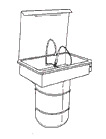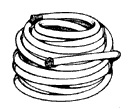Everyday Hazmat User’s Training Guide
Section I—Common USDA Forest Service Activities (continued)
Automotive and Small Engine Services
- The Activities
- Used Oil
- Used Oil Filters
- Batteries
- Tire Changes
- Antifreeze
- Degreasing
- Fueling
- Vehicle Washing
- Handy Tips
While most automotive maintenance activities have been outsourced, servicing functions are still found in some USDA Forest Service units. Try to eliminate all servicing activities and manage the remaining activities to ensure facility and worker safety and regulatory compliance. Follow these guidelines for specific regulatory concerns and waste reduction recommendations.
The Activities
Automotive Servicing—The Processes
Automotive servicing activities at USDA Forest Service units usually range from fueling and fuel storage, to changing oil and oil filters, servicing antifreeze, changing tires, degreasing parts, and changing lead-acid batteries.
This guideline does not cover servicing vehicle air-conditioning systems, repairing and rebuilding engines, cleaning and repairing radiators, repairing brakes, rebuilding transmissions and differentials, and painting vehicles. If some of these activities occur at your USDA Forest Service unit, consider outsourcing them immediately. If you are still performing these tasks, be careful to fulfill your regulatory obligations and to address facility and worker-safety issues.
 Used Oil |
 Used Oil Filters |
 Batteries |
 Tire Changes |
 Antifreeze |
 Degreasing |
 Fueling |
 Vehicle Washing |
 Handy Tips |
Used Oil
Used oil is an automotive servicing waste commonly found at USDA Forest Service units. Following simple procedures that are easy to implement, you can avoid regulatory issues and ensure environmental protection of public land. If you properly collect, store, and recycle your used oil, you do not have to treat it as a hazardous waste. Do not mix other materials with used oil because the used oil will be rejected for recycling if it contains solvents or other hazardous materials that make it a hazardous waste.
Used Oil Collection Storage
Used oil storage containers (such as tanks or drums) must be sound, securely closed at all times except when adding or removing used oil, and must be marked as USED OIL. Lock containers to ensure that only nonhazardous used oil is added to your collection unit. Use secondary containment (such as a metal pan) underneath all used oil collection containers to guard against leakage.

Do NOT throw used oil in the
trash or pour it on the ground.
Do NOT throw used oil in the trash or pour it on the ground.
Used Oil Recycling
Recycling is the best management practice for your used oil. Be sure to use a licensed recycler; you may be able to transport up to 55 gallons of used oil at a time in USDA Forest Service vehicles. Check with your State Highway Patrol. Keep all transportation information, including dates, amounts of used oil, destination, the transporter, and the EPA identification numbers of the recycler in your files.

Sample recordkeeping form for
recycling
used oil.
See the appendix.
Hazardous Used Oil
Used oil rejected by a recycler, or used oil mixed with solvent, is probably a hazardous waste; see the Hazardous Wastes guideline.

Sample training information for
personnel
handling used oil.
See the appendix.
